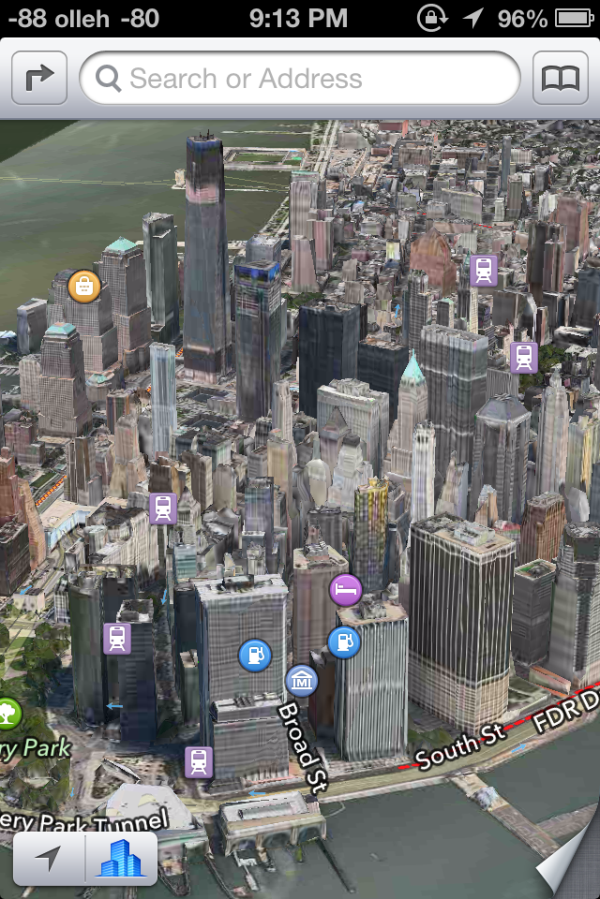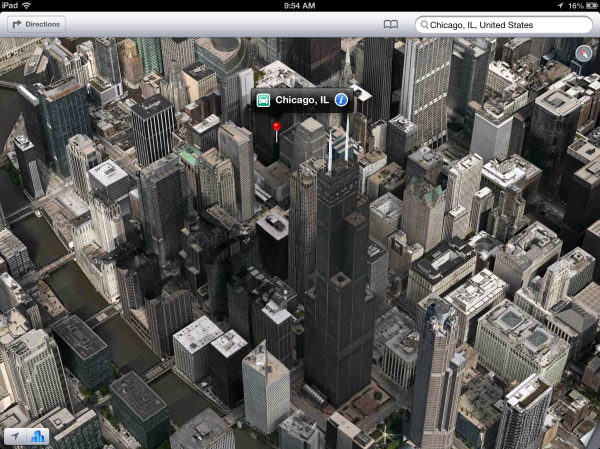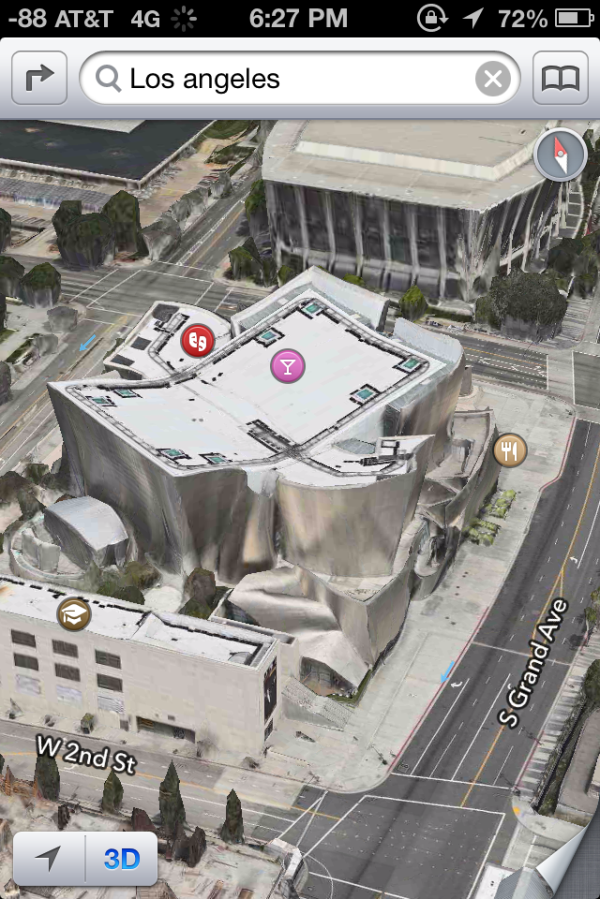The iOS 6 Review: Maps Thoroughly Investigated and More
by Brian Klug & Saumitra Bhagwat on September 19, 2012 2:21 PM EST3D Flyover
New in Maps is the 3D flyover feature which is limited in iOS 6 to devices with an A5 SoC or better. This means the iPhone 4 (GSM and CDMA), iPhone 3GS, and iPod Touch 4th Generation get excluded from the 3D buildings experience. 3D buildings already taxes the 4S considerably and drops frames from time to time, so I can see why the 4 and 3GS didn’t make the cut. 3D buildings on the iPhone 5 is completely fluid 60 fps, it seems.
On applicable devices, there’s a 3D button alongside the location indicator (which snaps to your present location or toggles compass mode) which toggles a perspective tilt. If theres a region in the current view with 3D building data and you’re at a sufficient zoom level, this changes to an icon with buildings, and tapping enables 3D building rendering. On excluded devices without the right SoC you simply don’t see this toggle at all and can’t two-finger tilt.
NYC was recently added to the iOS 6 3D Maps dataset
These buildings generated using aerial captures as I touched on earlier, and pop in with dynamic Level of Detail (LoD) both for geometry and textures. If you’ve used Google Earth on a mobile device and seen the 3D buildings Google has and the way they pop in, you’ll instantly know what I’m talking about. Generally the geometry starts very smoothed, and Apple has done a good job in iOS 6 of keeping visible switching around between levels hard to notice.
When it comes to evaluating the detail and quality of 3D buildings, the difficulty ultimately lies in selecting the right features to compare. I suspect Apple is also doing some hand massaging of building geometry in some of the more notable urban centers, something Google has told me they do as well, in addition to the user-contributed sketchup buildings. Thus, comparing notable landmarks gives an idea for the best case but not the empirically derived geometry that makes up most of the dataset. Of course in the dense urban environment reconstructing geometry and imagery requires a lot more hand massaging because of occlusions and other considerations.
Cities like Chicago are stunningly detailed.
The level of geometry detail is mostly great in the markets that I checked out. Trees and other geometry which isn’t like a building also gets represented, though some palm trees end up looking like elongated lightbulbs at times. It isn’t always perfect though.
A trouble building I found while making a cursory inspection of Los Angeles. Update: The building actually looks like this (Google Maps) as pointed out by a commenter. Still, it's possible to find buildings with strange geometry and textures applied in iOS 6.
I’ve browsed a lot of buildings which aren’t noteworthy landmarks or part of a city skyline and seen some interesting geometry and texture interpolation errors. Thankfully they’re not super common, and not even Google’s 3D database is free of them, so it’s nothing I hold against Apple’s crew.
The other question then becomes how many cities actually have 3D buildings available from Apple. To find out I manually checked the top 100 most populated cities in the USA and top 30 globally, and made a huge spreadsheet. Unfortunately as of my checking there really aren’t that many markets at all. In fact, it isn't much of a stretch to say that Apple's 3D buildings database is actually very limited at the moment, and basically only includes the USA.
Internationally, none of the top 30 cities have any 3D buildings. In fact, the only international 3D support that I’m aware of is a small region around the Sydney opera house, the Colosseum in Rome, and parts of London in the UK. I was actually surprised to see London get added into the dataset right for the iPhone 5 keynote, as I had checked and seen it was absent just a day before.
In the US, 26 or so cities have 3D building data as of this writing. For the number of the cities which do have it, it tends to be a small grid localized around the densest urban area, which isn’t surprising. Apple doesn’t seem to have prioritized its launch markets by population either, and there are some fairly notable exclusions as well.
Hopefully Apple continues building this dataset out at a good pace, because at present the dataset for 3D buildings and acceptable aerial photography is honestly disappointing compared to Google Earth's impressive dataset. That said, we've already seen Apple deploy more 3D markets between iOS 6 beta 4 and the GM. The question for the future is not only how long it will take to get adequate coverage of the top 100 markets in the USA and abroad, but beyond that point what the re-visit schedule for this dataset will be.













105 Comments
View All Comments
crankerchick - Thursday, September 20, 2012 - link
I was going to comment and quote the same statement. I'm an avid tech junkie. i've owned a variety of mobile electronics devices. I recently purchased first an iPad and then a MacBook Pro to replace my Xoom and Dell laptop and now I find myself feeling almost "forced" (I know no one forces me to spend my money) to buy an iPhone 5 because trying to find cross platform applications to sync with my Galaxy Nexus (which I really like) is just tough. Add in that iOS doesn't permit data sharing in the background, it makes being completely on iOS (for iCloud) or completely on Android for things to work together. Obviously, the Galaxy Nexus can't access iCloud, so to have things just seemlessly work together, I have to give up the iPad or migrate to the iPhone.It's obviously not the worse problem to have, but it sure is nice for things to work together. Right now, you really have to sign up for one or the other completely, for the best experience. Not to mention being on 2 different platforms means paying for the "same" app twice.
Fx1 - Wednesday, September 19, 2012 - link
When AT says on the internet that iOS STILL FEELS FRESH. You need to take a long hard look at your reporting because it stinks of Apple all over it.anactoraaron - Wednesday, September 19, 2012 - link
I know what you mean. I only had to read what was on the first page to see it. This is what first made me scratch my head..."Today, iPhone, iPad and iPod Touch make up a significant portion of Apple’s revenue, and as a result moving the platform along is more of a question of minimizing friction points rather than completely reinventing the OS. "
Why the hell not reinvent the wheel again? Oh right. Apple didn't reinvent it the first time around either. They 'stole' a bunch of ideas and put them together.
steven75 - Tuesday, September 25, 2012 - link
Yep, barely any phones these days look like that original 2007 iPhone.Oh no wait--THEY ALL DO!
Sufo - Thursday, September 20, 2012 - link
I have to agree. iOS does many things well, however "feeling fresh" is firmly at the bottom of that list. Visually, the experience has barely changed since the first iteration - yet the handsets cost, in essence, £1000 now...robinthakur - Thursday, September 20, 2012 - link
Well if you come from iOS5 to iOS6 it feels pretty fresh. I would imagine that this is what they meant. The changes are nice improvements in my cursory glance round them so far on iPad3 and IP4S, with Siri having massively improved in the UK. Having demo-ed it this morning in the office, a few people pre-ordered the IP5...I did buy a Samsung Galaxy 3 and kept it for a month, but didn't like the Android OS so went back to iPhone. Android does look nice (though obviously not as smooth) with some good ideas but I just felt that iOS is more integrated and some things just work more reliably. App choice was a big decider as well with a few of my favourite ones missing on Android, but the worst thing was the reception on the phone and the narrow ear-speaker which made me realise the 4S was actually quite good as a phone! If you feel restricted by the capabilities of the iPhone, then Android is probably a good bet, but I just bought it due to screen envy and wanting a new toy which then got bored after I finished playing.
Having gone from a WiMo phone back in 2007 to the first iPhone, and used Blackberrys, Sony P Series and others, I can say with certainty that anactoraaron's statement about "Apple didn't reinvent it the first time around either. They 'stole' a bunch of ideas and put them together. " is utter nonsense and the iPhone OS *was* completely revolutionary. People used to stop in the street and watch me using it, which seems unbelievable now, but true.
The best proof of this is that all phones now (barring perhaps Windows phone) operate and look like an iPhone. I concede though that if you never owned an iPhone/3G and went straight to Androids, perhaps they might even seem derrivative, but they were completely ground breaking when they were introduced.
maximumGPU - Thursday, September 20, 2012 - link
I went from ios 5 to 6, and it certainly doesn't feel novel.We've been having incremental improvements over the past 5 years, and while it was incredible in 2007, ios feels dated now.
It's gonna be windows phone for me now, that's a mobile os that feels "fresh".
Sufo - Friday, September 21, 2012 - link
Yes, windows phones are lovely - I adored my Lumia 800 (as a windows phone and as a physical handset) however lack of apps is a real and legitimate concern. If they can just drag more devs over I can really see windows being _the_ platform for "casual" phone users.Sufo - Friday, September 21, 2012 - link
Gonna have to disagree with you here. Not only does the jump from 5 to 6 not feel significant, it doesn't feel that different from the very first iteration (superficially).Stas - Sunday, September 23, 2012 - link
Loading the front page of AT doesn't give it away? O.o